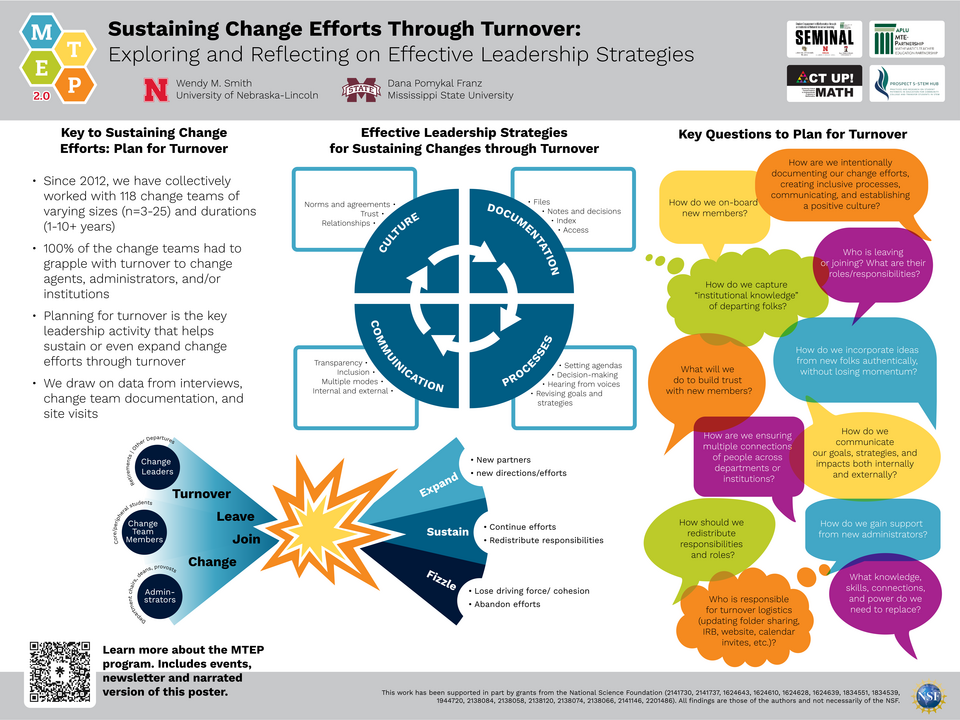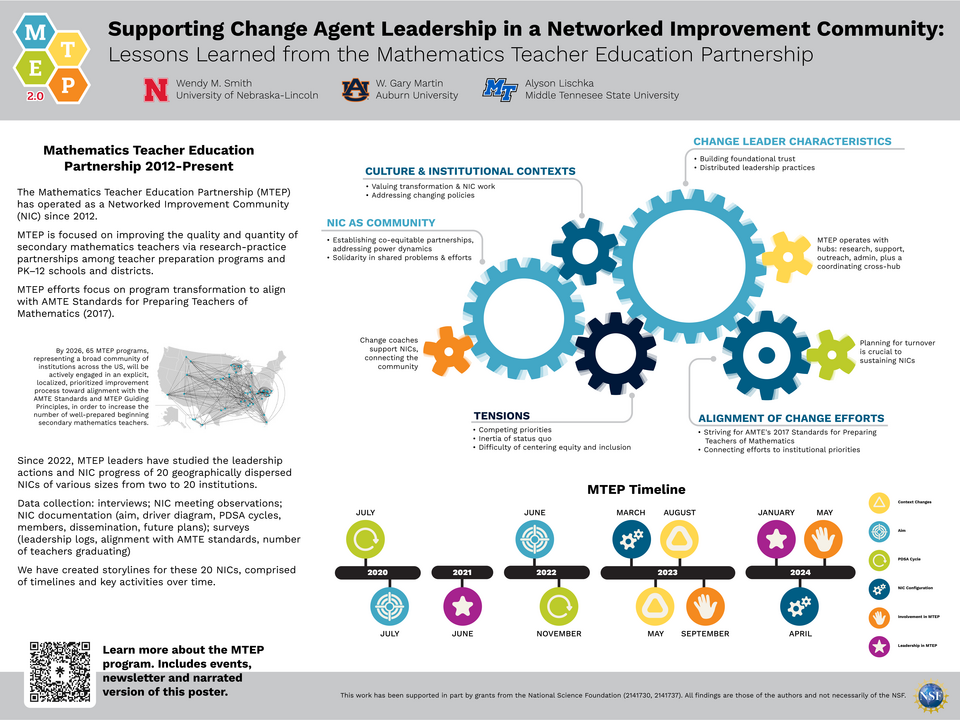INSPIRE. EMPOWER. TRANSFORM. FOR ALL.
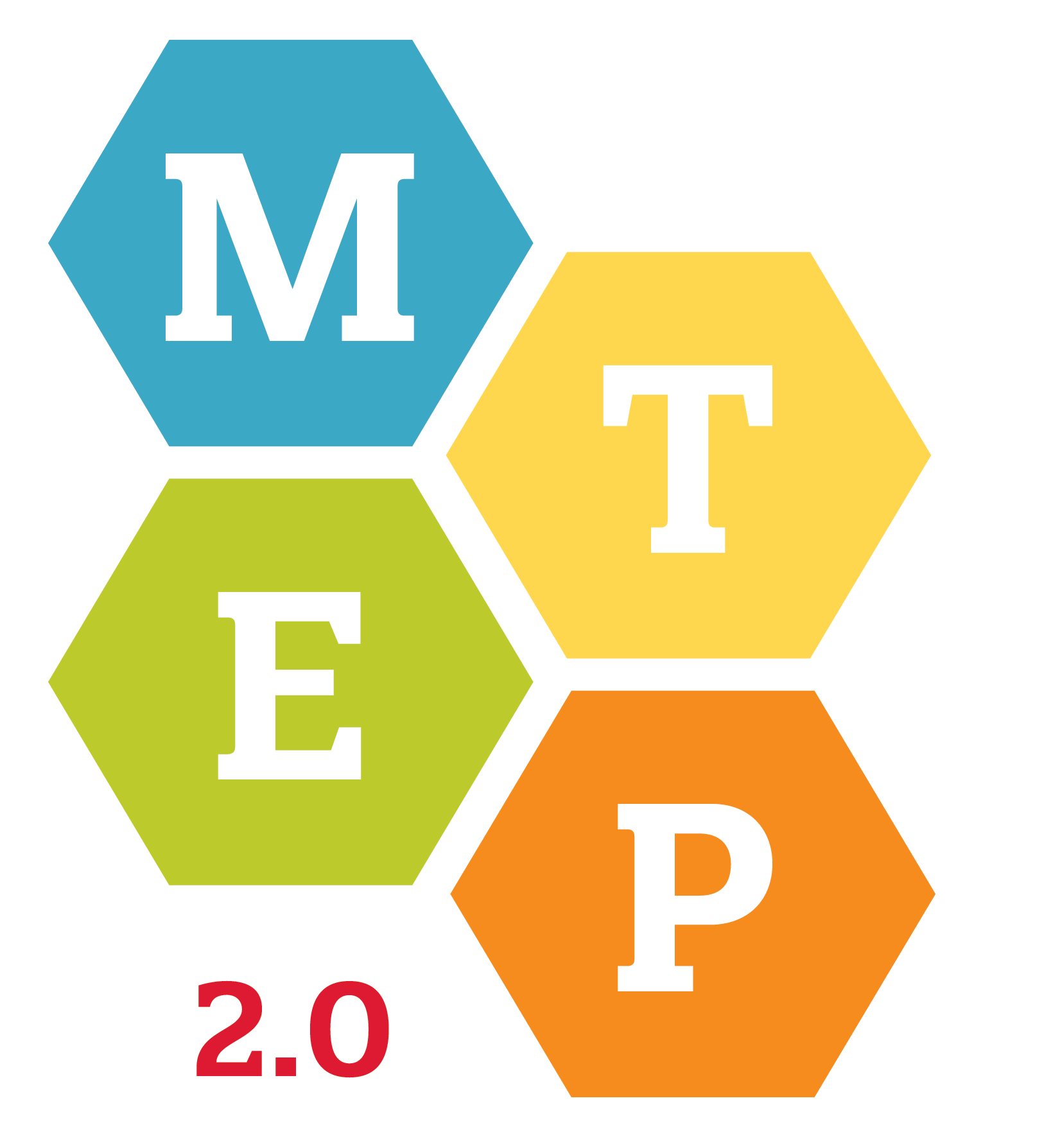
About MTEP 2.0
The Mathematics Teacher Education Partnership (MTEP) is a networked improvement community (NIC) of secondary mathematics teacher preparation programs across the country – working collaboratively to redesign secondary mathematics teacher preparation programs based on its Updated Guiding Principles for Secondary Mathematics Teacher Preparation and the Standards for Preparing Teachers of Mathematics.
First organized in 2011, MTEP has produced a substantial body of knowledge addressing common problems of practice in secondary mathematics teacher preparation. In 2020, a new iteration of the network titled MTEP 2.0 was launched, with a focus on supporting the efforts of local secondary mathematics teacher preparation programs to transform their efforts using the NIC design.
MTEP 2.0 welcomes all institutions involved in preparing secondary mathematics teachers; interested people may join an existing MTEP 2.0 team or form a new team (see below for more details about how to get involved). Local teams include a broad range of stakeholders in their improvement efforts, including mathematics teacher educators, mathematicians, K-12 school partners, and others with a stake in well-prepared mathematics teachers.
A grant from the National Science Foundation titled Collaborative Research: Using Networked Improvement Communities to Scale Up Program Transformation for Secondary Mathematics Teacher Preparation (NIC-Transform Scale Up; DUE-2141737, 2141730), was awarded to Auburn University and the University of Nebraska-Lincoln in October 2022 to scale up and study the emerging MTEP 2.0 network. MTEP 2.0 currently consists of 10 teams encompassing 46 programs across the nation.
Membership and Leadership
List of Teams
| Team | Institution |
|---|---|
| Central Alabama | Auburn University |
| Central Alabama | Tuskegee University |
| Columbus State University | Columbus State University |
| CSU Fullerton | CSU Fullerton |
| Florida International University | Florida International University |
| Iowa | Iowa Depart of Education |
| Iowa | Iowa State University |
| Kennesaw State University | Kennesaw State University |
| Kentucky | University of Kentucky |
| Kentucky | University of Central Florida |
| Middle Tennessee | Middle Tennessee State University |
| Middle Tennessee | Tennessee Tech University |
| Middle Tennessee | Tennessee State University |
| Mississippi State | Mississippi State University |
| Montana | University of Montana |
| Montana | Montana State University |
| MTEP Hui | University of Hawai'i at Hilo |
| MTEP Hui | University of Hawai'i at Mānoa |
| MTEP Hui | University of Hawai'i–West O'ahu |
| Nebraska | University of Nebraska-Lincoln |
| Nebraska | University of Nebraska at Omaha |
| Nebraska | University of Nebraska Kearney |
| North Carolina | Appalachian State University |
| North Carolina | North Carolina A&T University |
| North Carolina | North Carolina Central University |
| North Carolina | North Carolina State University |
| North Carolina | East Carolina University |
| North Carolina | University of North Carolina at Greensboro |
| North Carolina | University of North Carolina at Pembroke |
| North Carolina | University of North Carolina at Wilmington |
| North Carolina | University of North Carolina at Charlotte |
| North Carolina | Western Carolina University |
| Northern Arizona | Northern Arizona University |
| TEMME | Eastern Michigan University |
| Texas | Stephen F. Austin State University |
| Texas | Texas A&M University |
| The University of Alabama | The University of Alabama |
| University of South Carolina | University of South Carolina |
| Utah | Utah State |
| Wisconsin | University of Wisconsin – Oshkosh |
| Wisconsin | University of Wisconsin – Platteville |
| Wisconsin | University of Wisconsin – River Falls |
| Wisconsin | University of Wisconsin – La Crosse |
| Wisconsin | University of Wisconsin - Eau Claire |
| Wisconsin | University of Wisconsin - Stevens Point |
| Wisconsin | University of Wisconsin - Green Bay |
Leadership
W. Gary Martin, Auburn University
Director
Wendy Smith, University of Nebraska-Lincoln
Co-Director
Marilyn Strutchens, Auburn University
Outreach Leader
Alyson Lischka, Middle Tennessee State University
Research Leader
John Sutton, ResultED
Project Evaluator
Dana Pomykal Franz, Mississippi State University
Yvonne Lai, University of Nebraska-Lincoln
Margaret Mohr-Schroeder, University of Kentucky
Mohammed Qazi, Tuskegee University
Yvonne Lai, University of Nebraska-Lincoln
Diane Barrett, University of Hawaiʻi-Hilo
Basil Conway, Columbus State University
Cyndi Edginton, North Carolina State University
April Pforts, Iowa Department of Education
Meghan Leadabrand, University of Nebraska-Lincoln
MTEP 2.0 is a national network of 20 teams encompassing 46 programs and their partners, including mathematics teacher educators, mathematicians, K-12 school partners, and others with a stake in well-prepared mathematics teachers.
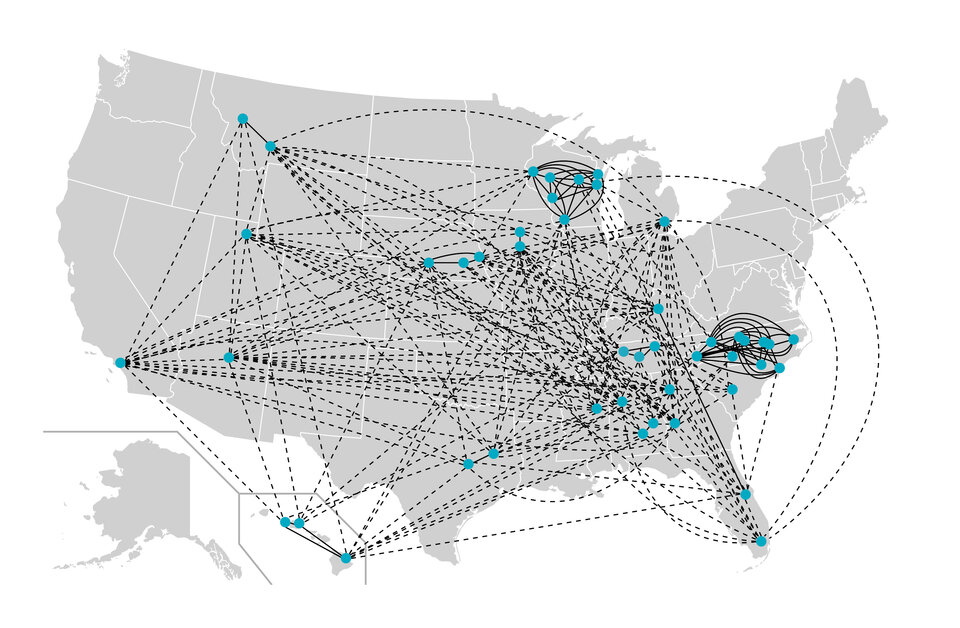
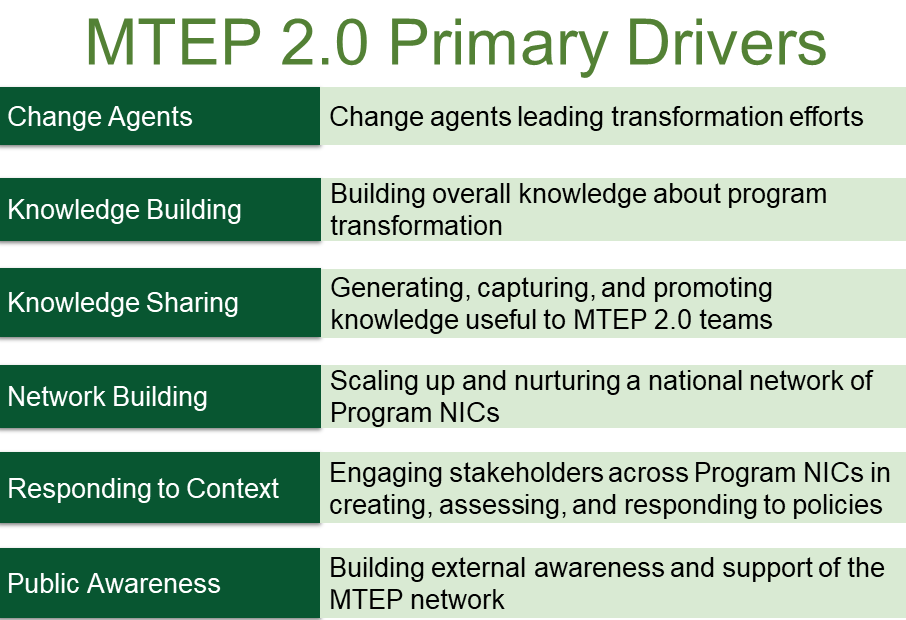
Design of MTEP 2.0
MTEP 2.0 uses a networked improvement community (NIC) design, championed by the Carnegie Foundation for the Advancement of Teaching, at multiple levels, from guiding local improvement efforts to guiding cross-team collaborations to guiding the network as a whole. A description of the overall MTEP 2.0 design, organized by key features of a NIC, follows:
- NICs are guided by a common aim: By 2026, 65 MTEP programs, representing a broad community of institutions across the US, will be actively engaged in an explicit, localized, prioritized improvement process toward alignment with the AMTE Standards and MTEP Guiding Principles, in order to increase the number of well-prepared beginning secondary mathematics teachers. Both the objectives and practices of the programs will foreground attention to promoting asset-based pedagogies, addressing power dynamics, fostering belonging in mathematics, and enhancing access to high-quality mathematics instruction to ensure the success of all students in mathematics.
- NICs are guided by a deep understanding of the problem and underlying system. The driver diagram in this section illustrates MTEP 2.0’s theory of action in achieving its aims.
- NICs engage in improvement efforts disciplined by the rigor of improvement science. Plan-Do-Study-Act cycles are used to guide the development, testing, and refinement of interventions.
- NICs are networked to accelerate progress across varied educational contexts.
How to Get Involved
All mathematics teacher preparation programs from any type of institution are welcome to become part of MTEP. Programs and their partners interested in becoming an MTEP 2.0 Team should contact Marilyn Strutchens, leader of the Outreach Hub. To learn more about the application process, see the Membership Toolkit.
Organizations and other institutions interested in working with MTEP 2.0 on policy issues and other concerns related to Secondary Mathematics Teacher education should contact Marilyn Strutchens, leader of the Outreach Hub.
Individuals interested in learning about the work of one of MTEP’s Research Action Clusters should see the following section, Learning From and With MTEP, on this webpage.
Membership Toolkit Join the MTEP 2.0 Communications List Subscribe to Our Newsletter
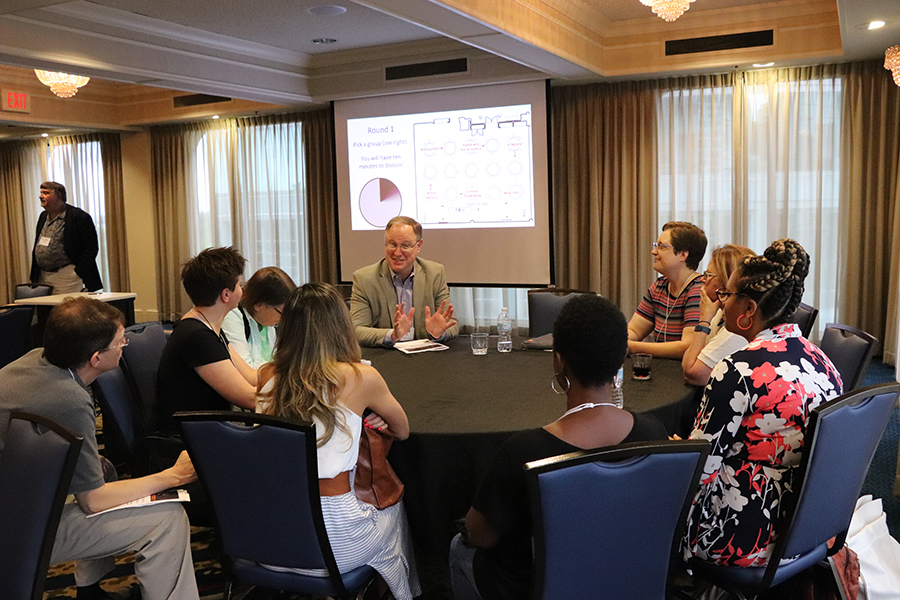
Learning from and with MTEP
Past Findings from MTEP
Work in the early years of MTEP was structured around Research Action Clusters (RACs), which focused on developing knowledge related to particular challenges in the preparation of secondary mathematics teachers.
- CERAC (Clinical Experiences RAC) - knowledge generated related to clinical experiences; CERAC-related publications
- MODULE(S2) (Mathematics of Doing, Understanding, Learning, and Educating for Secondary Schools) RAC - generates knowledge related to developing mathematical knowledge for teaching in content courses. The RAC and related MODULE(S2) NSF project has created curriculum materials that provide undergraduate mathematics instructors with a way to incorporate opportunities for prospective teachers to develop mathematical knowledge for teaching in university algebra, geometry, modeling, statistics, and capstone courses. The materials are designed to be taught with equity-based teaching practices, including going deep with mathematics and affirming mathematics learners’ identities for everyone taking the course. Access to the materials is freely available through the MODULE(S2) website, and research findings related to the materials are highlighted in MODULE(S2) publications.
- Active Learning Mathematics (ALM) - knowledge generated related to reform (towards active learning) in lower division mathematics courses, including an Open Canvas site and related NSF project, SEMINAL (Student Engagement in Mathematics through an Institutional Network for Active Learning). ALM-related publications
- Secondary Teacher Retention and Induction in Diverse Educational Settings (STRIDES) RAC: is a research action cluster (RAC) within the Mathematics Teacher Education Partnership (MTEP) that aims to increase the number of years that early career secondary mathematics teacher remain in the field by positively impacting their various professional support systems. See STRIDES publications
- Program Recruitment and Retention (PR2): PR2 publications
Policy Position Statements
MTEP has a repository of position statements that can be included for learning and discussion in upcoming courses and seminars.
Publications
- Secondary Mathematics Teacher Recruitment Campaign 2.0 (PR2) Implementation Guide (download)
- Tenth Annual MTEP Conference Proceedings, 2021-2022
- Ninth Annual MTEP Conference Proceedings, 2020
- Eighth Annual MTEP Conference Proceedings, 2019
- Seventh Annual MTEP Conference Proceedings, 2018
- Sixth Annual MTEP Conference Proceedings, 2017
- Fifth Annual MTEP Conference Proceedings, 2016
- Martin, W. G., Lawler, B. R., Lischka, A. E., & Smith, W. M. (Eds.). (2020). The mathematics teacher education partnership: The power of a networked improvement community to transform secondary mathematics teacher preparation. IAP.
Future Research for MTEP 2.0
MTEP 2.0 is committed to learning about how the networked improvement community structure can support, accelerate, and sustain secondary mathematics teacher preparation program transformation efforts locally, regionally, and nationally toward a goal of achieving more inclusive and equity-oriented teacher preparation programs that align with the AMTE Standards for the Preparation of Teachers of Mathematics.
We seek to understand both how to support transformation and how to overcome challenges to transformation across varied contexts with attention to the networked improvement communities as entities and the change agents that work within them.
Research Posters
History of MTEP 2.0
The first iteration of MTEP was convened by the Science and Mathematics Teaching Imperative of the Association of Public and Land-Grant Universities in early 2012 and worked to address the significant national shortage of well-prepared secondary mathematics teachers through a coordinated research, development, and implementation effort. The partnership took a comprehensive approach to tackling this challenge, convening community colleges, universities, and university systems, as well as K-12 schools, state departments of education, and other education-focused organizations.
The partnership aimed to support the improvement of secondary mathematics programs; promote partnerships among all sectors throughout the teacher development process, with a focus on promoting program transformation; develop and coordinate a networked research and development agenda; serve as a clearinghouse for model programs and practices; and advocate for change at university, state and national levels.
Over its initial years, MTEP focused largely on the work of research action clusters (RACs). Individuals within each RAC developed, tested, and refined solutions in their areas of work, generally following the Plan-Do-Study-Act (PDSA) model. As they demonstrated success, solutions developed by each RAC were made available to additional teams for extended testing, noting any adaptations that may be necessary to address the local context. Based on improvement science techniques, utilizing the power of the network, this development model followed the NIC design.
MTEP 2.0 launched in October 2020 with 19 partnership teams encompassing 43 secondary mathematics teacher preparation programs across 17 states. Since its inception, MTEP has hosted annual national conferences to organize the work of MTEP and MTEP 2.0. Multiple funded projects have supported various aspects of the work of the partnership, including its RACs and Working Groups, and launching and studying the MTEP 2.0 network.

The work of the Mathematics Teacher Education Partnership has been funded by grants from multiple funding agencies (National Science Foundation DUE-1624643, 1624610, 1624628, 1624639, 1834551, 1834539, 1726998, 1726853, 1726362, 1726744, 1726707, 1726098, 1726252, 1726723, 1726804, 2141146, 2141737, 2141730; Helmsley Charitable Trust). All findings are those of the authors, and not necessarily of the funding agencies.
